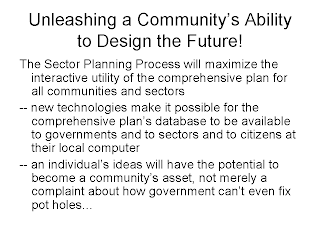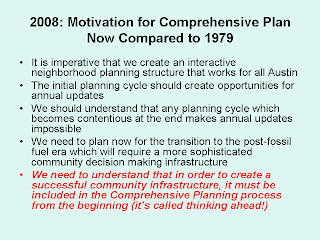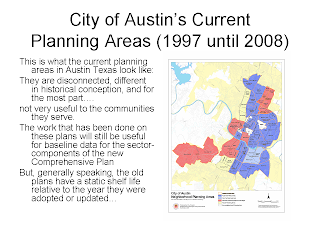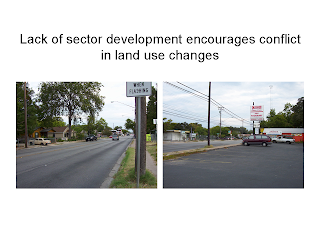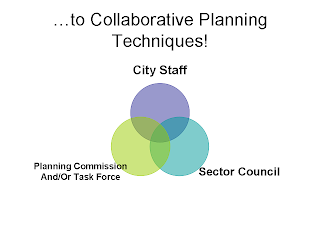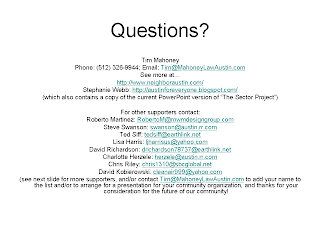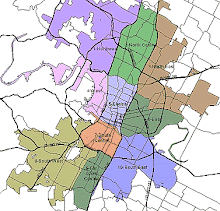Monday, December 29, 2008
Options for New Year
Sunday, November 30, 2008
Students at Work

When I read stories in the Statesman (or any news) that demonstrate use of student input, I jump up and down and dance. This city has been avoiding the use of its student population for years, and I am literally at a loss as to why. This city has one of the highest concentrations of students in the entire state of Texas, and we basically pat them on theirs heads, and tell them to fill up the punch bowl. Recently, I was inspired by the student input into the Waller Creek development, and after walking in the Waller Creek area today, I can honestly say that it needs a bunch of planners, students and developers working on it.
Student initiative is vital to a constantly changing city. For example, there are several downright ugly traffic medians ("islands" as they are called) which could use landscaping. Well, we could pay some landscaping firm to come up with an idea that might get into the budget 20 years later. Or, we could make these islands projects for landscape architecture students, landscaping students, or any other type of students who are in the process of learning about how to make the outdoors prettier. These bring up the value in the community and they provide experience for students before they graduate.
We have students, and pretending otherwise is detrimental to our local economy. Instead of paying them nothing and having them fill punch bowls, we should start putting them to good use and making it less possible for them to live in our city without becoming positively engaged in the good of the entire community.
Friday, November 28, 2008
Artisan Communities Exploit Non-Consumerism

One of the tragedies of the rise in the cost of living in Austin is that the city is losing a number of artist communities, or the possibility of gallery space. While the cost of living has risen, the community that supports art in Austin has become disconnected. What if someone is not as "high class" as the Blanton? What if someone wants more unity than a tour of studios? Full disclosure: I enjoy the Blanton and I enjoy the East Austin studio tour. However, I know that people enjoy an artisan community, and other than guitarists, I believe the city has a responsibility to support such a community.
Because there are still large quantities of space that have little to no development, a developer should buy a large parcel of land, and build 20 of those super small houses so that artists, writers, and musicians can have small spaces to practice their crafts, but not have a mountain of bills for basic maintenance. For those who are unfamiliar with the concept of a super small house, there are houses that are as small as 84 sq. ft. up to as large as 300 sq. ft. Single family housing is still incredibly inexpensive to build, so the profitability should be visible to the average developer. This would encourage more studios to be built, and might actually support a shared space so that people can know where to go for art.
In the past, artists have rented spaces separate from their homes to display and create their art. The high cost of living is one thing, but maintaining two separate residences makes art somewhat of a hobby for the superwealthy. Instead, creating an artisan community would allow artists the respect of separating their work from their private lives and promote a non-consumer mentality: if you only work there, you have little need for extra furniture and the rest of the trimmings that people usually put in their homes.
 The real challenge of Austin is that we all believe that density means putting everything in one place. What density actually means is making many opportunities available in several locations. All the live music venues, art galleries, and poetry slams should not be concentrated in 78701, 78702, 78703, 78704, and 78705. We have a big city, and one way to promote artists of all types is community exposure in several different locations. If a developer builds a community of studios, that developer is promoting art in Austin, and allowing people to see its good will in the promotion of Austin values.
The real challenge of Austin is that we all believe that density means putting everything in one place. What density actually means is making many opportunities available in several locations. All the live music venues, art galleries, and poetry slams should not be concentrated in 78701, 78702, 78703, 78704, and 78705. We have a big city, and one way to promote artists of all types is community exposure in several different locations. If a developer builds a community of studios, that developer is promoting art in Austin, and allowing people to see its good will in the promotion of Austin values.
Tuesday, November 25, 2008
Call to Action

Therefore, I am implementing a call to action. Instead of going to happy hours all the time and only networking with people you already know, go to a public meeting. Not only will it give you a chance to expand your network, but you might even catch a glimpse of what the other side is saying. Also, I know that many of you complain about what should be happening in Austin, but is taking too much time. Well, if you never say anything where someone who has power can hear you, it would be rather difficult to give you what you want.
Density, like adult literacy and child welfare, is a cause. If no one at the meeting supports being able to walk to work, the grocery, the bank and childcare, then politicians have to listen to the people who are at the meeting. Obama was elected because a bunch of young people used technology, networking, and community organization skills to support the greater good. Sprawl is not the definition of a strong society, and it will not matter that people wanted cars when the government runs out of money to support the automobile infrastructure, or for people to own an acre a piece, or for parents to drive their children everywhere. Be the change you want to see. If we choose to live in huge houses, buy wasteful vehicles and eat too much, we deserve what we get. Those of you who appreciate walking to the drug store, walking to the movies, and having businesses in your neighborhood without having to get into a car, get to the public meetings. The message is not clear when only one side is speaking.
Wednesday, October 29, 2008
Crossing the Street
 A lot of people argue that investing in a more pedestrian outlook would cost too much money. One thing that people have not considered is that there are many ways to slowly implement a more pedestrian society that do not cost a fortune. I advocate mass transit, wider sidewalks, and vertical mixed use. However, I know that those options are expensive and keep some citizens away from the center of town because of living costs. Those are ideas that take time and planning.
A lot of people argue that investing in a more pedestrian outlook would cost too much money. One thing that people have not considered is that there are many ways to slowly implement a more pedestrian society that do not cost a fortune. I advocate mass transit, wider sidewalks, and vertical mixed use. However, I know that those options are expensive and keep some citizens away from the center of town because of living costs. Those are ideas that take time and planning. Monday, October 13, 2008
Argument for Private Transportation
New Braunfels, Canyon City, Sattler, and Gruene are perfect examples of why all cities should not aspire to have heavy density. They maintain their individuality and provide nearby tourist destinations for the larger cities nearby, such as San Marcos, Austin, and San Antonio. Their profits are probably large because they exploit their value as small towns and as escapes from large cities. The biggest argument for density within large cities is that having a city of 500,000 be classified as a "town" is detrimental as far as businesses and public utility.
Sunday, October 5, 2008
Wednesday, October 1, 2008
Business Collaboration
Instead of having independent meetings at each business about where to grow and why, Austin businesses should discuss collaboration with other businesses to fill the empty facades. There is no reason why Taco Shack, Jo's Coffee, and a bookseller shouldn't be close to each other. Nonprofits could talk to businesses for something other than fundraising, building more comraderie between the entity types. Wouldn't it be an asset for Austin if the owner of Amy's and the owner of Mmmpanadas got together and said, "Hey, why don't we go into adjoining properties with a killer deck so that we can get customers from both angles?" Property in Austin is getting more expensive, and it would probably be easier to get more revenue if the Austin businesses took a more collaborative approach. After all, two successful businesses are more likely to get a loan they co-sign for than an independent loan these days.
Tuesday, September 16, 2008
Students in coffee shops

One of the real challenges in Austin is probably going to be coffeeshop culture. Now while it's true that McDonald's is starting to have some lattes and mochas that other coffee shops offer, the real challenge is how the independent coffee shops do business. One huge issue with coffee shops especially in a city like Austin is the number of students and workers who come in to coffee shops to do work. While it's important that coffee shops cater to everybody, the real challenge is going to be making sure that coffee shops can stay in business while workers come into them, and do homework for hours at a time. Many different independent coffee shops have had problems with this in the past, or at least the ones I've seen, when people don't order that many items from the menu, but they stay in the coffeeshop for hours at a time. That is helpful insomuch as there are people inside the coffeeshop, but it's a bad aspect for the coffeeshop business because there aren't enough people who can sit in a coffee shop which is being taken up with students with laptops doing homework. Some students need to be around other students to focus and study. However, if someone needs to be around other people to do his or her work that person needs to go place where there isn't a business that's expected to be run and where other people are sitting.
My solution is this: there need to be some larger coffee shops that have space specifically for students, but they need to disallow the rest of the space to be used for people who take up space with laptops. For example, if a student comes in and sits for half an hour to 45 minutes, that's not the worst thing in the world. Even regular patrons will probably sit for 30 to 45 minutes because we have such a strong coffee culture. The real challenge is when the student sits there for hours. A good tactic in that case would be for the manager to say after about an hour, especially if the coffeeshop is filled up, "Please move to the student section of the coffeeshop. We need the space for other customers, and there are too many people in here for you to sit here and not order anything for an extended period of time." Some people may say that this is fascist, largely because they fail to recognize that a table that only makes $12 because of three students for six hours can be the real death of a business. I guess that's one thing that McDonald's can do for us: they can offer a space where the business doesn't suffer just because students are sitting with WiFi and not order anything new.
Saturday, September 13, 2008
The "Supplemental Income" Job
 In Austin, there is a tendency to believe that there are enough jobs for everyone. This, in fact, is true. The challenge in Austin, however, is the ability to distinguish between what is a liveable job, and what is a "supplemental income" job. A liveable job is a job that allows two things: 1) financial stability, in which one is able to save, pay all bills, and potentially purchase a home; and 2) personal freedom, or the idea that one should be able to choose to ride a bus, have a roommate, go to additional schooling, participate in community activities, etc. Most of these jobs are located in many of the fields that Austinites do not practice: technology (no, not everyone is a "techie"), healthcare (more people, but takes a lot of education, and so not many), and law (that's lawyers, not support staff).
In Austin, there is a tendency to believe that there are enough jobs for everyone. This, in fact, is true. The challenge in Austin, however, is the ability to distinguish between what is a liveable job, and what is a "supplemental income" job. A liveable job is a job that allows two things: 1) financial stability, in which one is able to save, pay all bills, and potentially purchase a home; and 2) personal freedom, or the idea that one should be able to choose to ride a bus, have a roommate, go to additional schooling, participate in community activities, etc. Most of these jobs are located in many of the fields that Austinites do not practice: technology (no, not everyone is a "techie"), healthcare (more people, but takes a lot of education, and so not many), and law (that's lawyers, not support staff).Much of Austin is consumed with what I will call the "supplemental income" job. These jobs are positions that 1) do not require much schooling, but the hiring department is frequently impressed by schooling; 2) do not offer many marketable skills which allow people to get promoted or transition to other careers; and 3) do not pay very much. The reason that I name them "supplemental income" jobs is that they are mostly taken by women, and the idea is that there is another income, a spouse, that makes the real money. Young people of both sexes are starting to make up these positions, and therein lies the problem.
While it is good to have a number of positions that are available, Austin looks antiquated when determining that some positions are worth so much less than others. Administrative assistants do quite a bit of work running an office, but only executive assistants get a living wage. Cashiers are, perhaps, the most important people in a restaurant because they make sure people get the money to be paid, but cashiers make little money. All careers start at entry-level, but too many entry-level jobs require experience. Nowadays, I see paralegal positions, which are executive assistants to attorneys, being offered $9-11 an hour, and those jobs require experience or, often, a certificate.
Austin needs to recognize that it needs new ideas to mesh with the old ideas. There can only be so many cheap employers before the city realizes that it's starving its own economy. I think the only reason people want to continue to think of Austin as a "cheap" city is to keep wages low. One thing that can be said about many of the new businesses is that they create more liveable jobs. It's better to have people living in the city and contributing than it is to say, "We have lots of jobs," and none of them support a household. Not to mention that as the city transitions to a more dense environment, those "supplemental income" jobs will not pay the cost of living, even without a car payment.
If you want a graduate, check the debt for today's graduate, and then decide your salary, because too many people are choosing to stay in school rather than face bad jobs that don't pay enough for people to live. If you want experience, ask yourself why someone who has experience doing something elsewhere has experience with you. Most companies, departments, etc. have their own software and their own procedures, and just because someone did anything at another company doesn't mean that person is better than someone who can be trained for the job they're in, rather than the job they had. If your position is in a remote location, don't scrimp on the salary, because people most likely have to drive to get there, which means a car, gas, insurance and maintenance, and most people don't own their own cars.
Living in Bryker Woods
One time that shaped my opinion of a healthy neighborhood was when I decided that riding my bike with my eyes closed was a good idea. Well, of course it's not, but to a six-year-old, the idea is absolutely brilliant. So there I was, in my school's back parking lot, showing how well I could ride, and I promptly fell over and hurt my right hand. If you see me, ask me about my crescent shaped scar on my left hand. My hand was bleeding, I was crying, and I was scared because I was three blocks away from home. There were two landscapers at the school who noticed me crying, and without being asked by anyone (for it was only three of us), they helped me into the back of their truck, put up my bike, and drove me to my house. My parents were very grateful, and I learned that riding my bike with my eyes closed equals stitches.
I don't see this attitude in Austin anymore. Not only do I not see kids riding their bikes (and determining their independence), but I don't see this attempt to reach out to one's neighbors like they did 20 years ago. There is a real feeling that there are people who "understand" Austin, but don't understand that everyone's needs matter. Many of these people feel that Austin is being "infiltrated," as if human beings don't belong with other human beings. I wonder if these people would help a child if its parents lived in a condo and supported a streetcar system.
The reason I support density is that it supports an attitude of Austinites looking out for each other, small business owners, neighbors, visitors, etc. South Congress has had a number of break-ins, and that's largely because people don't see that the feeling of neighborhood closeness isn't something developed by businesses alone or neighborhoods alone. It's the attitude that we're all in Austin together, and we should look out for each other, from the grungy musician to the skipping toddler. We're all here anyway.
The Truth About Roads
Growth or...?
Change in Austin
Beautiful Sunday, September 7, 2008
After my walk, I went down to Juan in a Million for lunch and noticed that there were condo closeouts on Chicon and Cesar Chavez. Naturally, after lunch I had to walk in that direction and find out more about the property(www.waterstreetaustin.com). There I met the owner of Mode, another business owned by people under the age of 30, who also work other jobs (modeaustin@gmail.com). I realized that new development accentuates old businesses by increasing visibility and initiating business growth in an area. There are several businesses in Austin that have existed for years, but because they are in areas that are primarily residential, there are no people and less pedestrian traffic which makes it hard to see the fruits of labor. One thing development could do is work to make sure that it encourages the start of newer small businesses around older businesses, increasing the economic development.
The Saltillo stop is an excellent example of transit oriented development. The stop itself has restrooms, a stage for live music, lots of public seating, and of course, businesses across the street. Because of the delay in service for the Red Line, one of the businesses located there had to move. There are still some businesses that could benefit from their location at the Saltillo stop if Austin would only let them, white collar businesses that would encourage other white collar businesses to be located near transit, like maybe the tech industry. For those new to Austin, you can find the stop at 1601 E. 5th Street.
Finally, I viewed an open house put on by Constructive Ventures, who had two properties with availability. The first property, 2124 (www.twentyone24.com), had amazing spaces for people looking to live central, and start a small business downstairs. What is great about Constructive Ventures is that the company is Austin-based, therefore not just developing a product and leaving the area immediately. A counter-intuitive move by them includes forgoing a gym, which the agent explained lowered the HOA fees. The property is Este Condos, which take flex space, and add a hook (www.esteaustin.com). More than the properties, I loved hearing that Constructive Ventures sold space to the University of Texas at Austin charter school (http://www.utexas.edu/provost/elementary/), and they will be constructing a 50,000 square foot school, and that the Live Strong Foundation (livestrong.org) will be locating nearby, introducing even more jobs to the area.
For the people who are completely opposed to new development in East Austin: one could question your motives, largely because job availability and affordable housing were problems before the developers appeared. Several non-profits are creating white collar jobs, and luring more businesses keeping East Austin residents safe. Southwest Key (swkey.org) moved there over a year ago, giving an example of an educated Latino leader dedicated to bringing up the youth in the community, and showing them that all minorities are all things. All those minority businesses in East Austin are getting free advertising by the people located on their streets, and including new residents. While it may be more expensive to start a business, it's more expensive not to start a business, and keep an area stagnant.
Comprehensive Planning Committee, September 2, 2008
Today, we discussed the newest cause for strife: the streetcar. Here, people are largely concerned with where it goes and how to fund it. In my opinion, because the streetcar would open more areas to new development, developers who have money would be great sources of funding, and the streetcar might open the doors for more public-private funding and remove a source of tension. Also, a streetcar allows the potential for more urban rail, provided that Austinites work with the city and the developers to make a successful experience for the first streetcar. On the other hand, there are several native Austinites (and some new) who oppose the newest addition to public transit because they don't want to make it easier for developers to take over new land, and they don't know the public impact. My understanding is that as long as there's another way for people to get to work, people will use it.
Otherwise, the Committee watched a presentation by Capital Metro that further discussed the transit plans already in progress. This was interesting largely because most of the information presented is available on their website. There was one interested citizen who was speaking for "native Austinites" who created a moment of tension for the notion that the city had numbers for transit but no numbers for development. I would argue that development spurs from the interest of people. If no one wants to live in a certain area, there would be no development. If people don't support development in a certain area, development discontinues. Obviously, if people like a certain area, there will be more development. I am interested in seeing more businesses in Austin, and I for one would try my best to support more local start ups, because we need the jobs.
The one important thing for all Austinites to remember is that even if there were no growth in Austin and no people coming, there would still be higher gas prices. A lot of people in U. S. cities that aren't growing are facing the depressing reality that there isn't justification for more public transit (or highway construction), but people still have to get to work. It's devastating that because people are married to their automobiles, life requires people who make less than $30,000 to spend 25% or more on work transit.




